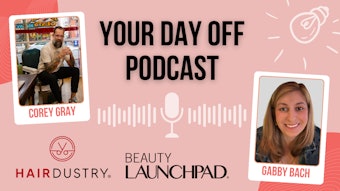
You stock high-quality products, have created a serene space and are an expert at performing soothing, professional spa treatments. Now, you need to ensure that clients are flowing in through your doors. Naturally, you’ll want to consider your marketing plan. You’ll need to include strategies that build awareness for your business, pique the interest of potential customers, solicit bookings and encourage return visits. One crucial aspect you’ll want to consider is your digital marketing plan.
Log in to view the full article
You stock high-quality products, have created a serene space and are an expert at performing soothing, professional spa treatments. Now, you need to ensure that clients are flowing in through your doors. Naturally, you’ll want to consider your marketing plan. You’ll need to include strategies that build awareness for your business, pique the interest of potential customers, solicit bookings and encourage return visits. One crucial aspect you’ll want to consider is your digital marketing plan.
You don’t want to neglect your digital presence in an increasingly online world. While it may feel challenging to get started, some simple considerations can help you create an effective digital marketing plan to support your business.
Digital Marketing Basics
Firstly, let’s define digital marketing. Your marketing strategy can include many channels, from the use of traditional print advertising to leveraging cutting-edge technologies like augmented reality and artificial intelligence. Digital marketing refers to any tactic that relies on online channels used to reach your audience. This includes the use of websites, content, email, SMS, and online and social media advertising strategies.
You’ve probably already gravitated to one or several of these methods, but if not, this should give you a place to begin. If you already have a digital marketing plan in place, think about ways you may want to expand on your approach. Let’s look at various channels and discuss ways to optimize your marketing strategy through each.
Website
Think of your website as your home base online. It’s likely to be your clients’ first digital point of contact with your spa, so it’s crucial that you include all the basic info they’ll need. Make it easy to see your location and services, and include a way for them to contact you.
One of the simplest updates you can make might have the biggest impact — considering that nearly half of visitors are likely viewing your website from their mobile phones, changing the telephone number on your website to a link means they can call you directly without having to type in the number themselves. All types of people may be looking to visit your spa, so aim to make your site as user-friendly and accessible as possible.
Beyond the basics, other features will make your website (and your spa, in turn) enticing to clients. For example, an online booking system is fantastic for clients who don’t like making calls. Educational blog content solidifies your expertise. An “About Us” page lets you tell your story to set yourself apart from other spas.
You don’t need to reinvent the wheel to have an effective web presence, but you’ll also want to consider search engine optimization (SEO). Search engines like Google crawl webpages to search for keywords to help people in your community find you. Think of what your prospective clients might try searching to learn about your business, and make sure these terms are included in your website’s content.
Related: 7 TikTok Marketing Tips
Social Media
You’ve probably witnessed the power social media has firsthand. It may even be the first thing you think of when you hear “digital marketing.” While it may not be everything you should consider, many businesses focus solely on social media, and it can be vital to your spa’s success.
When determining which platforms to use, what to post and how frequently to get on your socials, consider the demographic and psychographics of your clients and ensure you have a presence on the platforms where they spend the most time and are looking for services like the ones you offer. Facebook (Meta) and Pinterest are ideal for clientele aged 30+, while Instagram, X (formerly Twitter) and TikTok have a younger base. Most platforms have a slightly more active female audience, but X is an exception to this rule. YouTube is popular across the board, making it a great place to cast a wide net.1
If you are looking to invest in advertising through social media, you can target based on income level, interests, education level, etc. Once you know where your audience is, you can start making eye-catching content and ads. Create engaging content, like behind-the-scenes videos, client testimonials and promotions — think about the types of things you want to see in your feeds!
Email Marketing
Email marketing is a classic tool in the digital marketing playbook, but just because it’s been around for a while doesn’t mean that it’s no longer effective. Email marketing offers a more targeted reach than some other digital channels, frequently produces high click-through, and open rates and is one of the best ways to engage current and prospective clients. Unlike the marketing done through a third-party platform, your email subscribers won’t be affected by any changes made outside of your control, such as the algorithm updates or fluctuations in ad prices that regularly affect the social and search advertising space.
Offer clients the chance to opt in for email updates through your website, booking system, in-spa forms and other places where they get news about your business. Once clients opt in, they’ll become the basis of your email marketing list. From here, you can schedule content, such as newsletters, promotions, blog posts and seasonal spa offerings, to send to them.
Online Advertising
The digital space is also an excellent way to advertise. Like social media, you’ll want to consider where your base is most active and funnel your energy there. To simplify things, you can rely on the plug and play advertising on Meta and Google. Meta advertising can be used to create ads for Facebook, Instagram and Messenger, while Google ads appear on YouTube, websites partnered with Google, and of course, on Google pages.
With a business account, you can use these ad creation tools to fully customize your ad campaigns. You can enter relevant information, like your target audience’s demographic, interests, location and behavior, along with photos and marketing copy you’d like to use. These tools also allow you to enter your budget and customize your bid strategy — aka defining how much you’re willing to spend per impression or click.
To further enhance your digital presence and SEO, consider setting up a Google Business Profile. This free tool helps people looking for your spa on Google Search and Maps easily find key details such as your hours, phone number and location. You can also explore linking your Google Business Profile with Google Ads to gain visibility and attract more customers to your business.
Reviews and User-Generated Content
Reviews can be make or break when it comes to securing new clients. Prospective spa-goers are likely to search for customer feedback before booking an appointment. Positive reviews are reassuring, while too many negative ones will likely dissuade bookings (though they offer insight into what your spa needs to work on). You can incentivize clients to leave reviews by offering discounts on retail products or services, points in a loyalty program or entries into contests or giveaways. However, the best reviews are honest and genuine, so think of offering incentives as an avenue for gaining valuable feedback to help your business thrive.
Beyond search results, reviews can also bolster your reputation in online ads. Use quotes from happy clients as testimonials (with their permission, of course) or highlight the number of glowing reviews your business and staff have received.
In addition to documenting their experience in reviews, your clients may feel inclined to talk about their spa visits on social media. Promote a hashtag unique to your business and encourage clients to tag you. The content they produce is excellent for word-of-mouth promotion; plus, you can ask to share their content on your feeds, too. Content of happy clientele will help show off your spa practitioner skills while affirming your expertise.
Performance Monitoring
Now that you’ve set up your webpage, social media, email strategy, advertising and other digital tactics, you need to make sure that they’re working as intended. Thankfully, there are several tools and metrics you can rely on to provide the insight you need. Use analytics tools that track website traffic, social media engagement, click-through and conversion rates. Some of these analytics are built right into tools that you’ll already be using (like through a business account for social media), but you can also opt to use external services like Sprout Social or Hootsuite.
Analytics will show you what’s working and what’s not, allowing you to adjust accordingly. It can be unpleasant to learn that something you’ve put effort into isn’t paying off, but this shouldn’t deter you. Instead, treat underperforming strategies as a learning lesson and successful ones as future inspiration.
Online channels can open a world of opportunities for your spa. But with so many ways to go about your digital marketing strategy, it’s challenging to know how to get things started. With the ideas, strategies and considerations detailed above, you should have some thoughts on how to get started. You can start as slowly as needed until a more extensive digital marketing plan feels feasible. With time, creativity and performance analysis, you’re more than capable of using digital marketing tools effectively.
References:
- “Social Media Fact Sheet.” 2024. Pew Research Center. January 31, 2024. https://www.pewresearch.org/internet/fact-sheet/social-media/?tabItem=64e32376-5a21-4b1d-8f8b-5f92406db984.
Amber McBain, vice president of marketing & communications at Éminence Organic Skin Care, is an innovator with more than 15 years of marketing and communications experience. Continuously striving for improvement in customer experience modeling and brand management, McBain has spearheaded marketing strategies for the most successful product launches in Éminence’s history.





